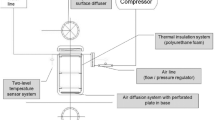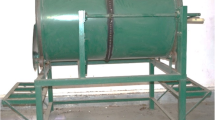Abstract
Vegetable trimming residues are very plentiful and diverse; however, their recycling involves environmental problems. Producing high quality compost from these residues is a way to make a good use of them. The present work studies the influence of the operating conditions used during a composting process of vegetable trimming residues (aeration, moisture, particle size, composting time), on the evolution of the temperature, pH and CO2 while the compost is producing and on the physico-chemical properties of the final compost (pH, organic matter, Kjeldahl-N, C/N ratio). An adaptive network based fuzzy inference system on basis of the four considered independent variables (aeration, moisture, particle size, composting time) was used to obtain the optima composting conditions which produce the best pH, temperature and CO2 evolution and the highest quality compost. Low aeration contents (0.2 Lair (min kg)−1), intermediate moisture content (55 %), medium-to-low particle size (1–3 cm) were the best operating conditions to obtain maximum temperatures and CO2 production. Moreover, under these conditions, it was obtained compost with satisfactory physico-chemical properties, useful for further agricultural application.




Similar content being viewed by others
References
Akhnazarova, S., Kafarov, V.: Experiment Optimization in Chemistry Chemical Engineering. Mir Publisher, Moscow (1982)
Allison, L.E.: Organic carbon. In: Black, C.A., Evans, D.D., White, J.L., Ensiminger, L.E., Clark, F.E., Dinauer, R.C. (eds.) Methods of Soil Analysis Vol II. SSSA Madison, WI (1965)
APHA (American Public Health Association): Standard Methods for the Examination of Water Wastewater. APHA, Washington DC (1995)
Beck-Friis, B., Smårs, S., Jönsson, H., Eklind, Y., Kirchmann, H.: Composting of source-separated household organics at different oxygen levels: gaining an understanding of the emission dynamics. Compost Sci. Util. 11(1), 41–50 (2003)
Bertoldi De, M., Vallini, G., Pera A.: Technological aspects of composting including modelling and microbiology. In: Gasser, J.K.R. (ed.) Composting of Agricultural and other wastes, pp. 27–40. Elsevier Applied Science Publishers, London (1985)
Bremnen, J.M.: Nitrogen-Total. In: Sparks, D.L. (ed.) Methods of Soil Analysis. SSSA, Madison (1996)
Bueno, P., Tapias, R., López, F., Díaz, M.J.: Optimizing composting parameters for nitrogen conservation in composting. Bioresour. Technol. 99(11), 5069–5077 (2008)
Bueno, P., Yañez, R., Caparrós, S., Díaz, M.J.: Evaluating environmental parameters for minimum ammonium losses during composting of trimming residues. J. Air Waste Manag. Assoc. 59(7), 790–800 (2009)
Choi, K.: Optimal operating parameters in the composting of swine manure with wastepaper. J. Environ. Sci. Health B 34(6), 975–987 (1999)
Delgado-Rodríguez, M., Ruiz-Montoya, M., Giraldez, I., Cabeza, I.O., López, R., Díaz, M.J.: Effect of control parameters on emitted volatile compounds in municipal solid waste and pine trimmings composting. J. Environ. Sci. Health A. 45(7), 855–862 (2010)
Demirbas, A.: Potential applications of renewable energy sources, biomass combustion problems in boiler power systems and combustion related environmental issues. Prog. Energy Combust. Sci. 31(2), 171–192 (2005)
Díaz, M.J., Alfaro, A., García, M.M., Eugenio, M.E., Ariza, J., López, F.: Ethanol pulping from tagasaste (Chamaecytisus proliferus L.F. ssp palmensis). A new promising source for cellulose pulp. Ind. Eng. Chem. Res. 43(8), 1875–1881 (2004)
Díaz, M.J., Eugenio, M.E., Jimenez, L., Madejón, E., Cabrera, F.: Modelling vinasse/cotton waste ratio incubation for optimum composting. Chem. Eng. J. 93(3), 233–240 (2003)
Díaz, M.J., Madejón, E., López, F., López, R., Cabrera, F.: Optimization of the rate vinasse/grape marc for co-composting process. Process Biochem. 37, 1143–1150 (2002)
Ekinci, K., Keener, H.M., Elwell, D.L.: Composting short paper fiber with broiler litter additives. Part I effects of initial pH carbon/nitrogen ratio on ammonia emission. Compost Sci. Util. 8(2), 160–172 (2000)
Emmanouilides, C., Petrou, L.: Identification control of anaerobic digesters using adaptive on-line trained neural networks. Comp. Chem. Eng. J. 21(1), 113–143 (1997)
Gray, K.R., Sherman, K., Biddlestone, A.J.: Review of composting II. The practical. Process Biochem. 6, 22–28 (1971)
Grigatti, M., Ciavatta, C., Gessa, C.: Evolution of organic matter from sewage sludge and garden trimming during composting. Biores. Technol. 91(2), 163–169 (2004)
Haug, R.T.: The Practical Handbook of Compost Engineering. Lewis Publishers, Boca Raton (1993)
Jang, J.S.R., Sun, C.T.: Neuro-fuzzy modeling control. Proc. IEEE 83(3), 378–406 (1995)
Jang, J.S.R.: ANFIS adaptive-network-based fuzzy inference system. IEEE Trans. Syst. Man Cybern. 23(3), 665–685 (1993)
Jingwen, T., Meijuan, G., Yujuan, X.: The study of compost quality evaluation modeling method based on fuzzy neural network for sewage treatment. In: Eighth ACIS International Conference on Software Engineering Artificial Intelligence Networking and Parallel/Distributed Computing, vol. 2, pp. 558–563. Qingdao, China (2007)
Kipp, C.E.: Optimum process parameters for composting sludge. Biocycle 25(9), 39–40 (1992)
Kuhad, R.C., Chandna, P., Singh L., Singh A.: Composting of lignocellulosic waste material for soil amendment. bioaugmentation, biostimulation and biocontrol In: Soil Biology, vol. 28, part 1, pp. 107–128. Springer, Berlin (2011)
Kulcu, R., Yaldiz, O.: Determination of aeration rate kinetics of composting some agricultural wastes. Bioresour. Technol. 93(1), 49–57 (2004)
Liang, C., Das, K.C., McClendon, R.W.: The influence of temperature moisture contents regimes on the aerobic microbial activity of a biosolids composting blend. Bioresour. Technol. 86, 131–137 (2003)
Lynch, J.M.: Substrate availability in the production of composts. In: Hoitink H.A.J., Keener H. (eds.) Proceedings of the International Composting Research Symposium, pp 24–35 (1992)
Madejón, E., Díaz, M.J., López, R., Cabrera, F.: New approaches to establish optimum moisture content for compostable materials. Bioresour. Technol. 85(1), 73–78 (2002)
Merelli, E., Armano, G., Cannata, N.: Agents in bioinformatics computational and systems biology. Brief Bioinf 8(1), 45–59 (2007)
Mulvaney, R.L. Nitrogen-inorganic forms In: Sparks, D.L. (ed.) Methods of Soil Analysis, vol. III, pp. 1123–1184. SSSA, Madison (1996)
Nahm, K.H.: Factors influencing nitrogen mineralization during poultry litter composting calculations for available nitrogen. Worlds Poultry Sci. J. 61(2), 238–255 (2005)
Nakasaki, K., Yaguchi, H., Sasaki, Y., Kubota, H.: Effect of pH control composting of garbage. Waste Manag. Res. 11(2), 117–125 (1993)
Nogueira, W.A., Nogueira, F.N., Devens, D.C.: Temperature pH control in composting of coffee agricultural wastes. Water Sci. Technol. 40(1), 113–119 (1999)
Poincelot, R.P. A scientific examination of the principles practice of composting. Compost Sci. 15(Summer), 24–31 (1974)
Qin, X.S., Huang, G., Chakma, A., Xi, B.: A fuzzy composting process model. J. Air Waste Manag. Assoc. 57(5), 535–550 (2007)
Ranalli, G., Bottura, G., Taddei, P., Marchetti, R., Sorlini, C.: Composting of solid sludge residues from agricultural food industries. Bioindicators of monitoring compost maturity. J. Environ. Sci. Health A. 36(4), 415–436 (2001)
Saber, M., Mohammed, Z., Badr-el-Din, S., Awad, N.: Composting certain agricultural residues to potting soils. J. Ecol. Nat. Environ. 3(3), 78–84 (2011)
Shaw, K., Day, M., Krzymien, M., Mohmad, R., Sheehan, S.: The role of feed composition on the composting process. I. Effect on composting activity. J. Environ. Sci. Health., Part A 34(6), 1341–1367 (1999)
Sikora, L.J., Sower, M.A.: Effect of temperature control on the composting process. J. Environ. Qual. 14, 434–439 (1985)
Tang, L., Zeng, G., Liu, J., Xu, X., Zhang, Y., Shen, G., Li, Y., Liu, C.: Catechol determination in compost bioremediation using a laccase sensor and artificial neural networks. Anal. Bioanal. Chem. 391(2), 679–685 (2008)
Thambirajah, J.J., Zulkali, M.D., Hashim, M.A.: Microbiological biochemical changes during the composting of oil palm empty-fruit-bunches. Effect of nitrogen supplementation on the substrate. Bioresour. Technol. 52, 133–144 (1995)
Tomati, U., Galli, L., Pasetti, E., Volterra, E.: Bioremediation of olive-mill wastewaters by composting. Waste Manage. Res. 13, 509–518 (1995)
Yager, R.R., Filev, D.P.: A simple adaptive defuzzification method. IEEE. Trans. Fuzzy Syst. 1, 69–78 (1993)
Yang, S.T.: Bioprocessing for value-added products from renewable resources. In: Yang, S.T. (ed.). Elsevier, Ohio (2006)
Zadeh, L.A.: Fuzzy sets. Inf. Control 8, 338–353 (1965)
Zucconi F., Monaco A., Forte M.: Phytotoxins during the stabilisation of organic matter. In: Gasser J.K.R. (ed.) Composting of Agricultural and Other Wastes, pp. 73–85. Elsevier Applied Science Publications, London (1985)
Acknowledgments
Special thanks for the collaboration of the technical support at IRNAS (CSIC).
Author information
Authors and Affiliations
Corresponding author
Rights and permissions
About this article
Cite this article
Díaz, M.J., Eugenio, M.E., López, F. et al. Neural Models for Optimizing Lignocellulosic Residues Composting Process. Waste Biomass Valor 3, 319–331 (2012). https://doi.org/10.1007/s12649-012-9121-y
Received:
Accepted:
Published:
Issue Date:
DOI: https://doi.org/10.1007/s12649-012-9121-y




